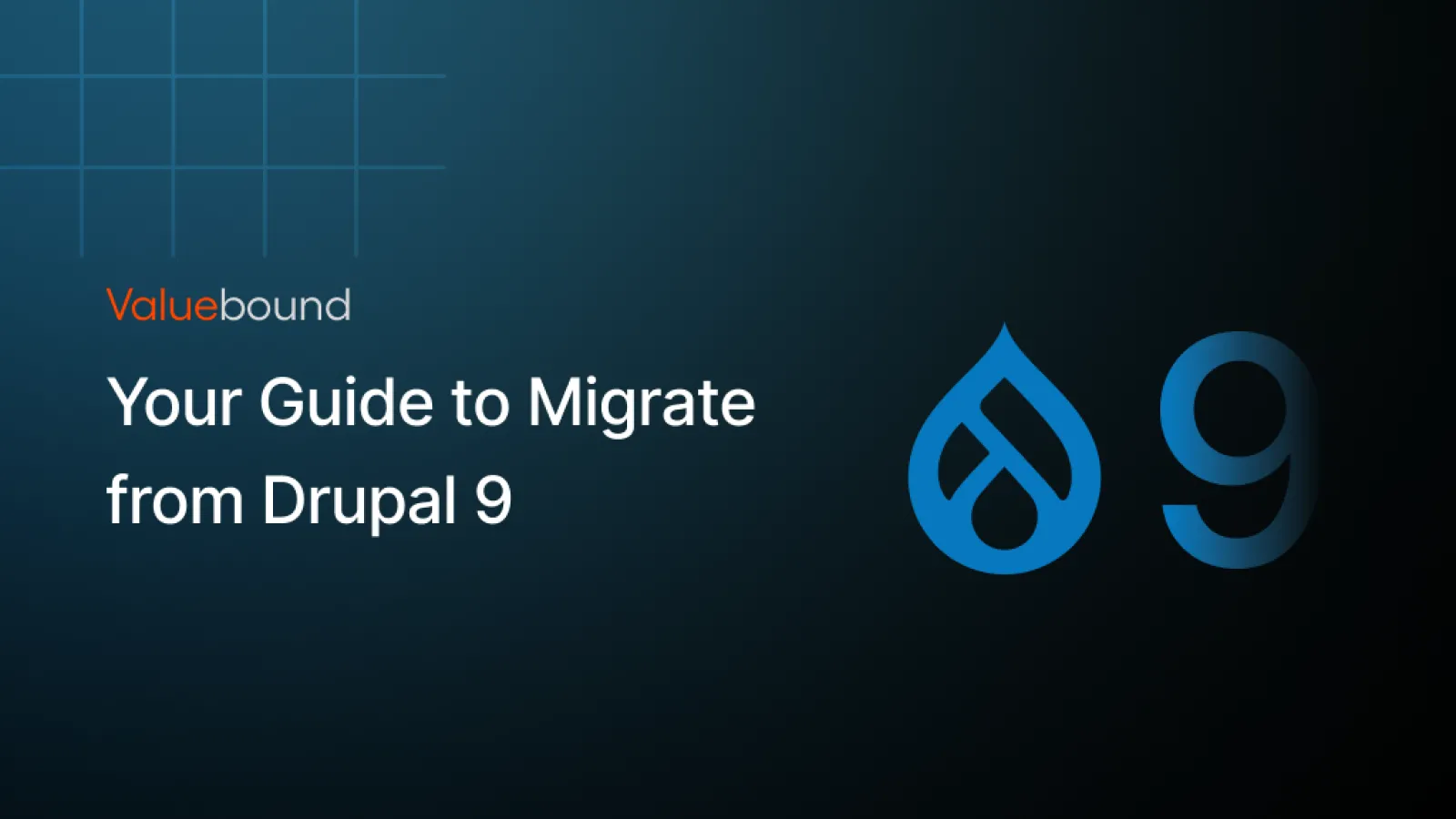Drupal 9 upgrade and migration is the hot topic that's keeping digital transformation leaders across enterprises up on their heels. While the tech landscape keeps updating, open-source content management systems like Drupal, too undergo seismic shifts. Many people are still not aware of when is Drupal 9 end-of-life. Well, first of all, the Drupal 9 EOL happened on November 1, 2023. That is why the need to migrate and upgrade from Drupal 9 has become even more urgent than ever before. While we do understand the ease of using a CMS over a prolonged period, enterprises are now faced with a pressing challenge- upgrade or risk vulnerabilities. In this Drupal 9 upgrade and migration guide, we unpack the "how," "why," and "what next" of Drupal migration and upgrade, equipping decision-makers with actionable insights.
Why Migrate from Drupal 9?
Why should you even care to upgrade to Drupal 9 now? Well, we have strong reasons to back the arguments:
1. Security Risks
With D9 end-of-life, enterprises are no longer under the cover to receive security updates. Unsupported versions often expose websites to vulnerabilities, such as data theft, security breaches, and compliance issues. For finance or healthcare industries, compliance is a non-negotiable; and hence, the risk becomes untenable.
2. Technological Advancements
The next upgrade and migration that you can eye is Drupal 10. It includes some of the latest innovative features like better backend with Symfony 6, improved front-end capabilities, and modern APIs for seamless integration. Upgrading to Drupal 10 means that enterprises sign up for not just the latest innovations, but also remain competitive in the digital-first ecosystem.
3. Cost-Efficiency
Maintenance costs rise significantly for unsupported software. Migrating early minimizes technical debt and ensures optimized infrastructure performance. Enterprises managing multiple websites can achieve scalability while reducing overhead costs.
Drupal Migration and Upgrade: How to Prepare?
Migration from Drupal 9 is not just a technical decision that enterprises need to take, but it's also a strategic move. Hence, all CIOs and digital transformation leaders have a stake at this quest. A fairly simple roadmap can tell you how you can prepare to upgrade and migrate from Drupal 9 to Drupal 10 or higher versions:
1. Conduct a Site Audit
A thorough Drupal site audit identifies:
- Outdated modules and dependencies.
- Performance bottlenecks.
- Areas requiring redesign or cleanup.
This step ensures your migration plan addresses legacy issues while capitalizing on new opportunities.
2. Assess Custom Modules and Themes
Custom Drupal development often means bespoke modules tailored to your needs. Identify compatibility issues with Drupal 10 and evaluate whether existing customizations require rewriting or retiring.
3. Plan for Scalability
For enterprises managing multi-brand or multi-location operations, scalability is a priority. Evaluate your current architecture and determine how Drupal 10’s capabilities, such as decoupled architecture, can support growth.
The Migration Process
Migrating from Drupal 9 to Drupal 10 follows a structured approach:
1. Update Core and Modules
Upgrade Drupal core to the latest version of 9.x before transitioning. Ensure contributed and custom modules are also updated to their latest versions.
2. Compatibility Testing
Test modules, themes, and integrations for compatibility with Drupal 10. Tools like Upgrade Status can provide a clear roadmap.
3. Migrate Custom Code
For organizations heavily reliant on custom Drupal development, this step is critical. Refactor code to align with Drupal 10’s updated APIs and eliminate deprecated functions.
4. Front-End Refinement
Drupal 10 introduces CKEditor 5, enhancing content creation experiences. Review your front-end design to ensure it aligns with these updates and modern UX standards.
5. Deployment and A/B Testing
Before your site goes live, it is essential to test it in the dev or staging environment. This will help in seamless integration with third-party systems like CRM or ERP platforms.
How to Overcome Challenges
Challenges are an inevitable part of migration and upgrade. However, choosing the right service partner can help you make this transition as smooth as possible. Here's how you can overcome challenges while migrating and upgrading from D9 to D10 or higher:
1. Resource Allocation
Migration demands skilled resources across development, testing, and project management. Enterprises often face a dilemma: scale in-house teams or partner with specialized agencies. Either way, prioritizing expertise ensures a smooth transition.
2. Governance and Collaboration
Fragmented governance across departments can delay migrations. Implementing collaborative workflows and defining clear ownership can mitigate this.
3. Integration Complexities
For digital transformation leaders, aligning Drupal capabilities with enterprise-wide systems can be daunting. Drupal 10’s API-first approach simplifies integration with key systems, but proactive planning is essential.
ROI is a By-Product of Migration & Upgrade
The end goal of any enterprise shouldn't be a simple migration and upgrade from D9 to D10 or higher versions. Let's understand that this is imperative for a digitally-optimized future. To maximize your investment, here's what you can do:
1. Leverage Automation
Drupal 10’s streamlined workflows and enhanced editor experiences reduce manual interventions. Automation boosts efficiency, accelerates time-to-market, and minimizes errors.
2. Keep Customer Experience as Your Focal Point
Fragmented customer journeys are a common pain point. Use Drupal 10’s enhanced personalization features to deliver cohesive experiences across touchpoints.
3. Go For Scalable Architectures
The direct benefit of migration enterprises can achieve is when they choose headless or decoupled architectures. This will offer higher flexibility, faster front-end delivery, higher TTM, and quicker multi-platform publishing.
Why Act Now?
Postponing migration increases costs and risks, leaving organizations vulnerable. Enterprises managing multiple websites or high-traffic platforms can’t afford disruptions caused by unsupported software.
Consider this: migrating early ensures security, compliance, and scalability—key factors for any enterprise aiming to maintain a competitive edge. But most enterprises and Drupal folks understand that the best part of this open-source CMS is community support. The active community support helps in problem-solving and keeping operations agile.
Conclusion
Migrating from Drupal 9 to Drupal 10 isn’t just about upgrading to the next version—it’s about stepping into a future of innovation and efficiency. If you’re a CIO, CTO, or digital transformation leader, we know this decision goes beyond technical updates. It’s about ensuring your systems are secure, scalable, and delivering a seamless customer experience.
With a clear migration strategy in hand and an eye on building future-ready architectures, you can take this step with confidence. Let’s not wait for potential vulnerabilities to catch us off guard—this is the time to act and safeguard your digital ecosystem for the road ahead.





